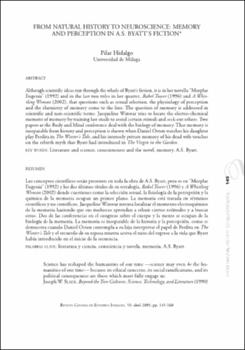From Natural History to Neuroscience: Memory and Perception in A.S. Byatt¿s Fiction
Autor
Hidalgo Andréu, PilarFecha
2005Resumen
Although scientific ideas run through the whole of Byatt’s fiction, it is in her novella “Morpho
Eugenia” (1992) and in the last two titles in her quartet, Babel Tower (1996) and A Whis-
tling Woman (2002), that questions such as sexual selection, the physiology of perception
and the chemistry of memory come to the fore. The question of memory is addressed in
scientific and non-scientific terms. Jacqueline Winwar tries to locate the electro-chemical
moment of memory by training her snails to avoid certain stimuli and seek out others. Two
papers at the Body and Mind conference deal with the biology of memory. That memory is
inseparable from history and perception is shown when Daniel Orton watches his daughter
play Perdita in The Winter’s Tale, and his intensely private memory of his dead wife touches
on the rebirth myth that Byatt had introduced in The Virgin in the Garden. Los conceptos científicos están presentes en toda la obra de A.S. Byatt, pero es en “Morpho
Eugenia” (1992) y los dos últimos títulos de su tetralogía, Babel Tower (1996) y A Whistling
Woman (2002) donde cuestiones como la selección sexual, la fisiología de la percepción y la
química de la memoria ocupan un primer plano. La memoria está tratada en términos
científicos y no científicos. Jacqueline Winwar intenta localizar el momento electroquímico
de la memoria haciendo que sus moluscos aprendan a rehuir ciertos estímulos y a buscar
otros. Dos de las conferencias en el congreso sobre el cuerpo y la mente se ocupan de la
biología de la memoria. La memoria es inseparable de la historia y la percepción, como se
demuestra cuando Daniel Orton contempla a su hija interpretar el papel de Perdita en The
Winter’s Tale y el recuerdo de su esposa muerta activa el mito del regreso a la vida que Byatt
había introducido en el inicio de la secuencia.





